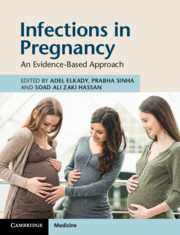Book contents
- Infections in Pregnancy
- Infections in Pregnancy
- Copyright page
- Contents
- Contributors
- Foreword
- Preface
- Section 1 Vaccination
- Section 2 Infections in Pregnancy
- Section 3 Postpartum Infections
- Chapter 29 Puerperal Sepsis
- Chapter 30 Puerperal Endometritis
- Chapter 31 Puerperal Mastitis
- Chapter 32 Breast Abscess
- Chapter 33 Pelvic Inflammatory Disease
- Index
- References
Chapter 29 - Puerperal Sepsis
from Section 3 - Postpartum Infections
Published online by Cambridge University Press: 11 October 2019
- Infections in Pregnancy
- Infections in Pregnancy
- Copyright page
- Contents
- Contributors
- Foreword
- Preface
- Section 1 Vaccination
- Section 2 Infections in Pregnancy
- Section 3 Postpartum Infections
- Chapter 29 Puerperal Sepsis
- Chapter 30 Puerperal Endometritis
- Chapter 31 Puerperal Mastitis
- Chapter 32 Breast Abscess
- Chapter 33 Pelvic Inflammatory Disease
- Index
- References
Summary
The World Health Organization defines puerperal sepsis as ‘infection of the genital tract occurring at any time between the onset of the rupture of membranes or labor and the 42nd day postpartum’.
Sepsis in the puerperium is still an important cause of maternal morbidity and mortality.
In the UK, according to the 2012–14 maternal mortality report, it accounts for 10 deaths per year.
Globally, puerperal sepsis is a major cause of maternal death and accounts for 15 per cent of all maternal deaths in developing countries. It is also a major cause of morbidity (long-term health problems, e.g. chronic pelvic pain, chronic pelvic inflammatory disease (PID) and infertility.
Severe sepsis with acute organ dysfunction has a mortality rate of 20–40 per cent, rising to around 60 per cent if septicaemic shock develops.
In the UK, 2012–14 maternal mortality report, direct sepsis (genital tract sepsis and other pregnancy-related infections) and indirect sepsis (influenza, pneumonia, others) accounted for seven maternal deaths, being the second cause of maternal mortality after cardiac disease.
- Type
- Chapter
- Information
- Infections in PregnancyAn Evidence-Based Approach, pp. 175 - 179Publisher: Cambridge University PressPrint publication year: 2019



